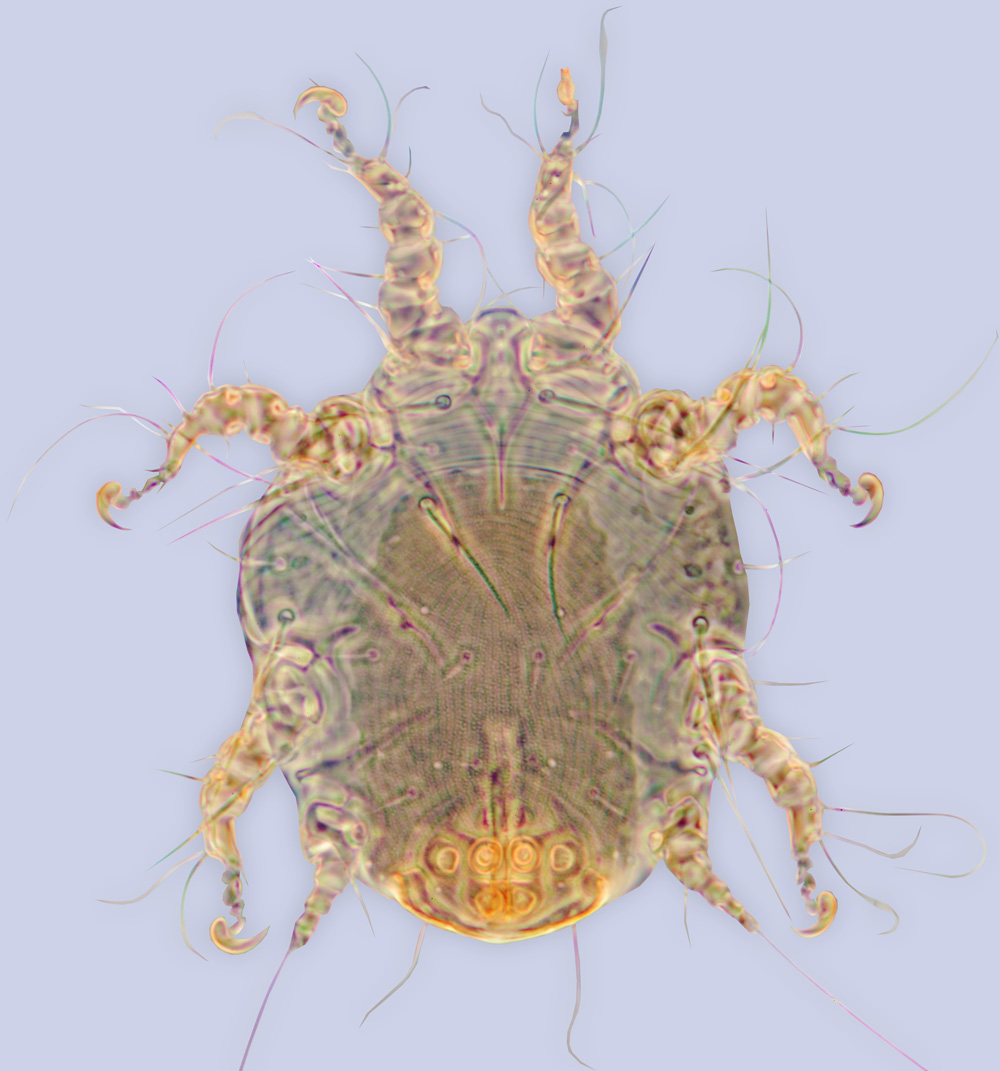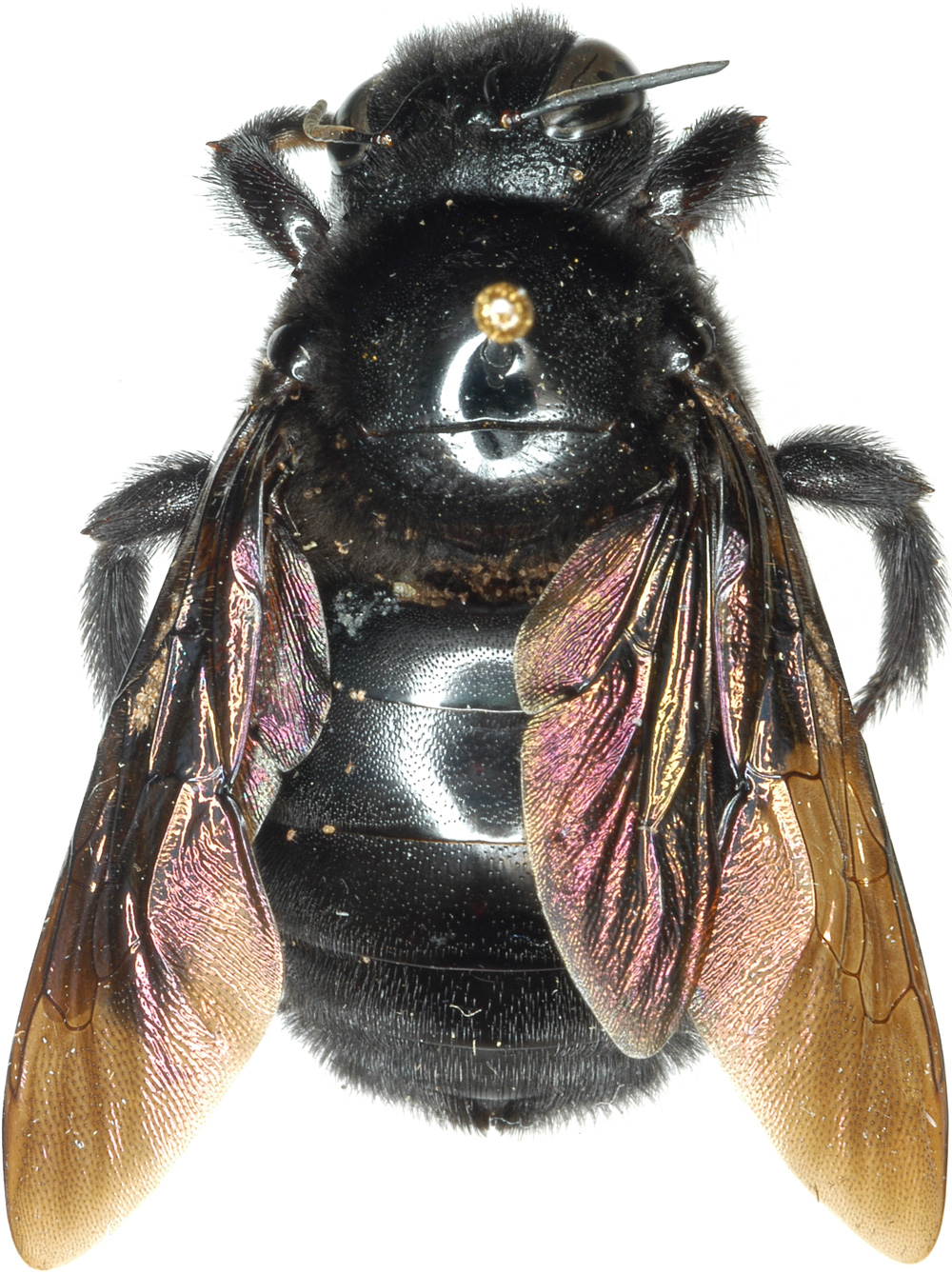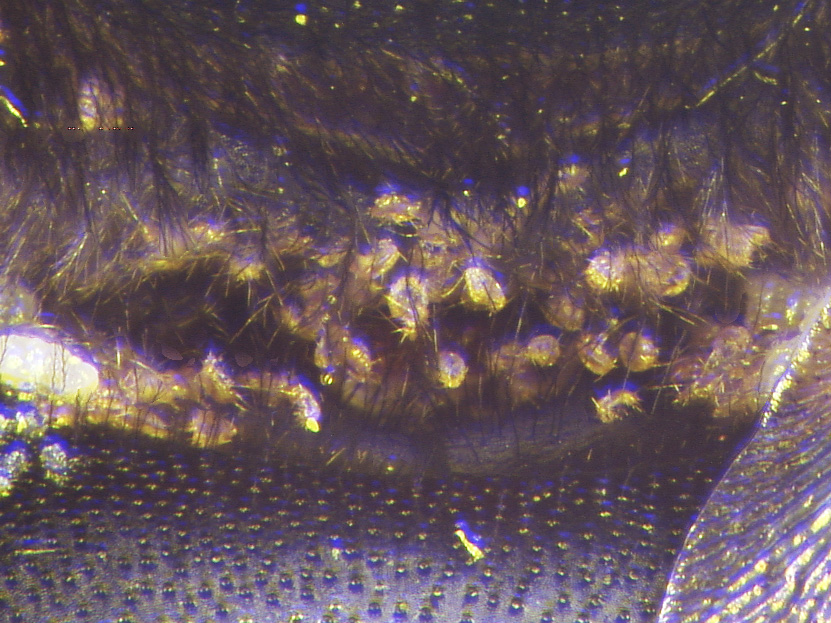Bee Mites : Acari : Acariformes : Sarcoptiformes : Chaetodactylidae : Sennertia : Sennertia species
Sennertia pirata Klimov and OConnor, 2008
Sennertia pirata Klimov & OConnor, 2008: 176, Figs 90-91
Material (show database records). Holotype: 1 HDN - BAHAMAS: Bimini, South Bimini Island, ex Xylocopa sp. (a new species identified by P. Hurd) on 1st metasomal tergite, 11 Jul 1951, C. & P. Vaurie, AMNH BMOC 04-0508-310; Paratypes: 17 HDNs – same data; 29 HDNs - BRITISH VIRGIN ISLANDS: Guana Island, hotel area, 18°29'N 64°34'W, ex X. mordax propodeum, 5 Jul 1993, R. R. Snelling, LACM 208276, BMOC 04-1122-011; 11 HDNs – same locality, plantation area, Centrosema virginianum (Fabales: Fabaceae), ex X. mordax hind femur area, 29 Oct 1992, R. R. Snelling LACM 208277, BMOC 04-1122-012; 2HDNs- CUBA: Ciudad de La Habana, Havana, no date, ex m Xylocopa cubaecola, Baker, CUIC, HK 84-0907-003; 7 HDNs - La Habana, Vedado, ex X. cubaecola on propodeum, 1 Sep 1993, J. A. Genaro, USNM, BMOC 05-0420-125; 29 HDNs - USA: Puerto Rico, Ponce Co., Playa de Ponce (label reads Ponce), ex X. mordax mesosoma, 25 Mar 1939, T. H. Hubbell #5 UMMZ, HK 90-1212-009; 5 HDNs - Virgin Islands of the United States, St. Croix Co., Frederiksted, X. mordax, 25 Mar 1927, no collector, CUIC, HK 84-1210-002. Holotype in AMNH, paratypes in AMNH, CUIC, LACM, UMMZ, UNAM, USNM.
Description. Phoretic deutonymph. Gnathosomal solenidia shorter than 1/3 of femur I width. Supracoxal setae scx situated on separate small sclerite. Hysterosomal shield lateral gland openings and bases of f2 nearly on edge of hysterosomal shield, or the former outside the shield. Lateral edges of hysterosomal shield in anterior part not narrowing. Dorsal hysterosomal pouch absent. Distance between anterior margin of hysterosomal shield and setae si exceeds diameter of si bases. Striate pattern of idiosomal cuticle outside hysterosomal shield without sclerotization, formed by long striae. Distinct rudiments of vi present. Setae si distinctly posterior se, exceed 1/2 of se, almost as thick as se. Diameter of si exceeds 1/2 of diameter of se. Setae c1 distinctly longer than d1-h1, long, nearly as long as se, situated on anterior edge of hysterosomal shield. Setae d1 and e1 nearly uniform in length with h1. Setae d1 situated on hysterosomal shield. Sclerite between ia and d2 present. Setae e2 subequal with d2, not touching hysterosomal shield. Lateral gland openings situated on hysterosomal shield. Setae 4b, g, and 4a with rhomb-like widening (sometime weakly-developed). Setae 4b, pR I-II, sR III, wF IV, gT I-II, hT I-II, kT III, and ra I-II filiform or nearly filiform (wa I-II spiniform). Posterior apodemes II and anterior apodemes III free. Anterior apodemes IV not interrupted, almost straight. Posterior apodeme IV absent. Conoids ps2 posterior to anterior transverse level of central suckers (ad1+2), anterior to ps1, situated outside outer level of ad1+2. Transparent margin of anterior suckers (ad3) without rough sclerotization. Suckers ad3 not enlarged, smaller than central suckers. Posterior and lateral borders of attachment organ not forming distinct frame. Sclerotized rudiment of anterior cuticular suckers present. Longitudinal hysterosomal sclerite present, long. Ventral hysterosoma distinctly striated. Genual setae mG I-II simple, mG II almost as long as leg II or longer. Tarsal setae la I-II longer than famulus ε. Tarsal setae ra I-II not bifid, blade-like. Tarsal setae wa I-II and s III spiniform (at least s III with rounded apices). Tarsal setae d I-II distinctly widened, lanceolate. Tarsal setae d and f I-II almost symmetrical, not touching. Solenidion ω3 closer to f I than to ω1. Posterior condylophore present. Anterior condylophore I-II with distal bending. Seta d III situated close to tarsal base, distance usually subequal or shorter than diameter of d III alveolus. Leg IV protruding posterior edge of hysterosoma. Tarsus IV not enlarged, shorter or less than 2 times longer than width of trochanter IV. Setae w IV thinner than d IV and distinctly shorter than leg IV, situated on middle of tarsus IV. Setae s IV present. Setae wF IV not reaching apex of tarsus IV.
Hosts. Xylocopa (Neoxylocopa) cubaecola, Xylocopa (Neoxylocopa) mordax, Xylocopa sp.
Distribution (Show map). Bahamas, British Virgin Islands, Cuba, USA: Puerto Rico, Virgin Islands of the United States.
Etymology. Pirata (=sea-robber, corsair) is a Latin noun in apposition.
References
Klimov, P. B. & B. M. OConnor. 2008. Morphology, evolution, and host associations of bee-associated mites of the family Chaetodactylidae (Acari: Astigmata), with a monographic revision of North American taxa. Miscellaneous Publications Museum of Zoology University of Michigan.199: 1-243.
Image Gallery
B. OConnor and P. Klimov ©
Created: May 26, 2011
Last modified: 



